10 Continuations
Blocks are usually used within a script. The continuation of a block within a particular script is the part of the computation that remains to be completed after the block does its job. A continuation can be represented as a ringed script. Continuations are always part of the interpretation of any program in any language, but usually these continuations are implicit in the data structures of the language interpreter or compiler. Making continuations explicit is an advanced but versatile programming technique that allows users to create control structures such as nonlocal exit and multithreading.
In the simplest case, the continuation of a command block may just be the part of the script after the block. For example, in the script
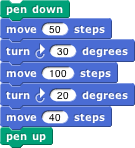
the continuation of the move 100 steps block is

But some situations are more complicated. For example, what is the continuation of move 100 steps in the following script?

That’s a trick question; the move block is run four times, and it has a different continuation each time. The first time, its continuation is
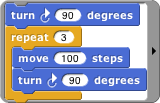
Note that there is no repeat 3 block in the actual script, but the continuation has to represent the fact that there are three more times through the loop to go. The fourth time, the continuation is just

What counts is not what’s physically below the block in the script, but what computational work remains to be done.
(This is a situation in which visible code may be a little misleading. We have to put a repeat 3 block in the picture of the continuation, but the actual continuation is made from the evaluator’s internal bookkeeping of where it’s up to in a script. So it’s really the original script plus some extra information. But the pictures here do correctly represent what work the process still has left to do.)
When a block is used inside a custom block, its continuation may include parts of more than one script. For example, if we make a custom square block 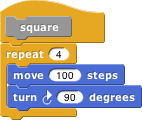
and then use that block in a script:

then the continuation of the first use of move 100 steps is
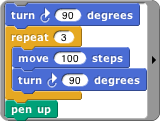
in which part comes from inside the square block and part comes from the call to square. Nevertheless, ordinarily when we display a continuation we show only the part within the current script.
The continuation of a command block, as we’ve seen, is a simple script with no input slots. But the continuation of a reporter block has to do something with the value reported by the block, so it takes that value as input. For example, in the script

the continuation of the 3+4 block is

Of course the name result in that picture is arbitrary; any name could be used, or no name at all by using the empty-slot notation for input substitution.
Continuation Passing Style
Like all programming languages, Snap! evaluates compositions of nested reporters from the inside out. For example, in the expression  Snap! first adds 4 and 5, then multiplies 3 by that sum. This often means that the order in which the operations are done is backwards from the order in which they appear in the expression: When reading the above expression you say “times” before you say “plus.” In English, instead of saying “three times four plus five,” which actually makes the order of operations ambiguous, you could say, “take the sum of four and five, and then take the product of three and that sum.” This sounds more awkward, but it has the virtue of putting the operations in the order in which they’re actually performed.
Snap! first adds 4 and 5, then multiplies 3 by that sum. This often means that the order in which the operations are done is backwards from the order in which they appear in the expression: When reading the above expression you say “times” before you say “plus.” In English, instead of saying “three times four plus five,” which actually makes the order of operations ambiguous, you could say, “take the sum of four and five, and then take the product of three and that sum.” This sounds more awkward, but it has the virtue of putting the operations in the order in which they’re actually performed.
That may seem like overkill in a simple expression, but suppose you’re trying to convey the expression

to a friend over the phone. If you say “factorial of three times factorial of two plus two plus five” you might mean any of these:
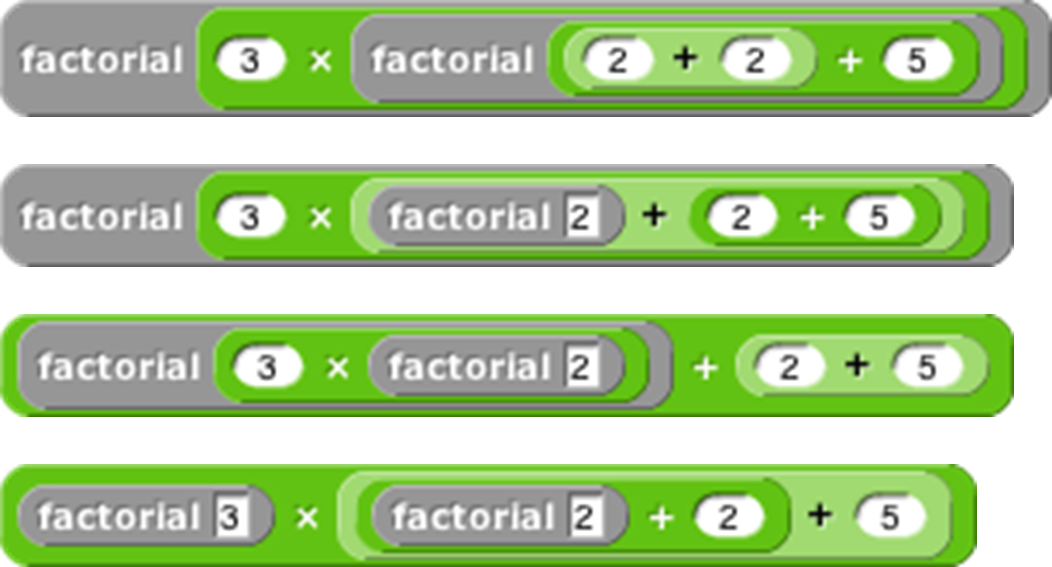
Wouldn’t it be better to say, “Add two and two, take the factorial of that, add five to that, multiply three by that, and take the factorial of the result”? We can do a similar reordering of an expression if we first define versions of all the reporters that take their continuation as an explicit input. In the following picture, notice that the new blocks are commands, not reporters.

We can check that these blocks give the results we want:
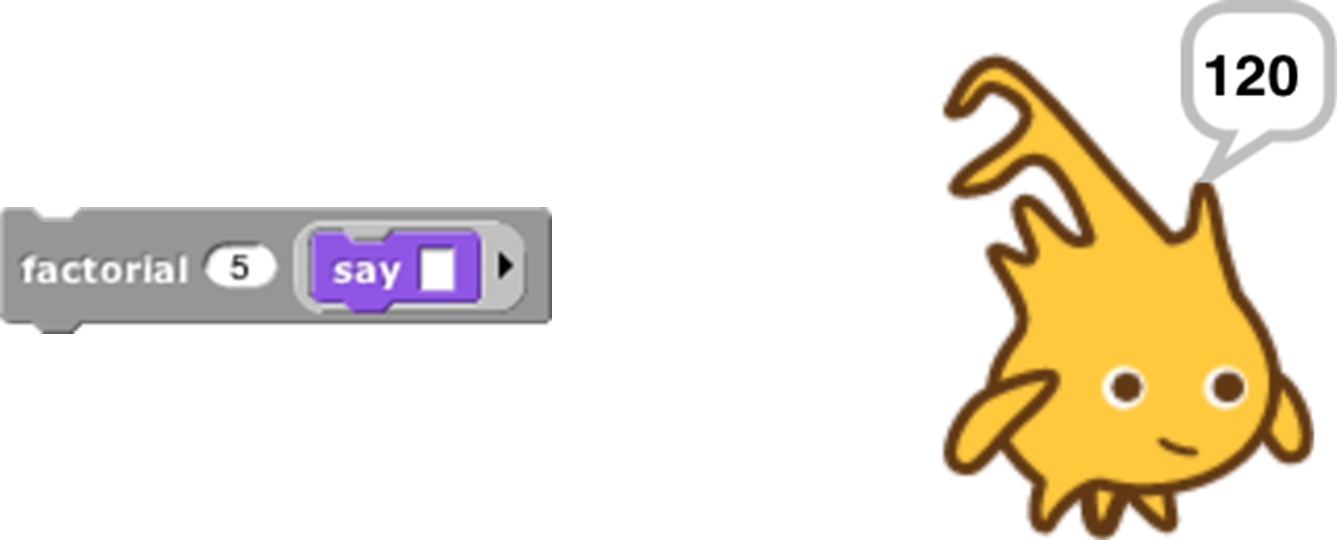
The original expression can now be represented as
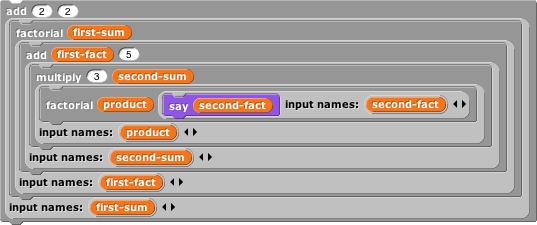
If you read this top to bottom, don’t you get “Add two and two, take the factorial of that, add five to that, multiply three by that, and take the factorial of the result”? Just what we wanted! This way of working, in which every block is a command that takes a continuation as one of its inputs, is called continuation-passing style (CPS). Okay, it looks horrible, but it has subtle virtues. One of them is that each script is just one block long (with the rest of the work buried in the continuation given to that one block), so each block doesn’t have to remember what else to do—in the vocabulary of this section, the (implicit) continuation of each block is empty. Instead of the usual picture of recursion, with a bunch of little people all waiting for each other, with CPS what happens is that each little person hands off the problem to the next one and goes to the beach, so there’s only one active little person at a time. In this example, we start with Alfred, an add specialist, who computes the value 4 and then hands off the rest of the problem to Francine, a factorial specialist. She computes the value 24, then hands the problem off to Anne, another add specialist, who computes 29. And so on, until finally Sam, a say specialist, says the value 2.107757298379527×10132, which is a very large number!
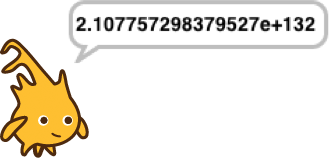
Go back to the definitions of these blocks. The ones, such as add, that correspond to primitive reporters are simple; they just call the reporter and then call their continuation with its result. But the definition of factorial is more interesting. It doesn’t just call our original factorial reporter and send the result to its continuation. CPS is used inside factorial too! It says, “See if my input is zero. Send the (true or false) result to if. If the result is true, then call my continuation with the value 1. Otherwise, subtract 1 from my input. Send the result of that to factorial, with a continuation that multiplies the smaller number’s factorial by my original input. Finally, call my continuation with the product.” You can use CPS to unwind even the most complicated branched recursions.
By the way, I cheated a bit above. The if/else block should also use CPS; it should take one true/false input and two continuations. It will go to one or the other continuation depending on the value of its input. But in fact the C-shaped blocks (or E-shaped, like if/else) are really using CPS in the first place, because they implicitly wrap rings around the sub-scripts within their branches. See if you can make an explicitly CPS if/else block.
Call/Run w/Continuation
To use explicit continuation passing style, we had to define special versions of all the reporters, add and so on. Snap! provides a primitive mechanism for capturing continuations when we need to, without using continuation passing throughout a project.
Here’s the classic example. We want to write a recursive block that takes a list of numbers as input, and reports the product of all the numbers:
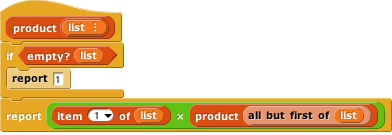
But we can improve the efficiency of this block, in the case of a list that includes a zero; as soon as we see the zero, we know that the entire product is zero.

But this is not as efficient as it might seem. Consider, as an example, the list 1,2,3,0,4,5. We find the zero on the third recursive call (the fourth call altogether), as the first item of the sublist 0,4,5. What is the continuation of the report 0 block? It’s

Even though we already know that result is zero, we’re going to do three unnecessary multiplications while unwinding the recursive calls.
We can improve upon this by capturing the continuation of the top-level call to product:
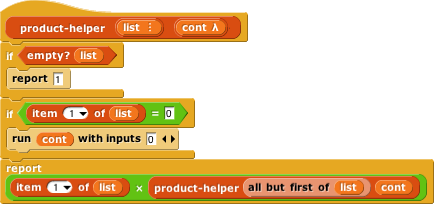

The  block takes as its input a one-input script, as shown in the product example. It calls that script with the continuation of the call-with-continuation block itself as its input. In this case, that continuation is
block takes as its input a one-input script, as shown in the product example. It calls that script with the continuation of the call-with-continuation block itself as its input. In this case, that continuation is

reporting to whichever script called product. If the input list doesn’t include a zero, then nothing is ever done with that continuation, and this version works just like the original product. But if the input list is 1,2,3,0,4,5, then three recursive calls are made, the zero is seen, and product-helper runs the continuation, with an input of 0. The continuation immediately reports that 0 to the caller of product, without unwinding all the recursive calls and without the unnecessary multiplications.

I could have written product a little more simply using a Reporter ring instead of a Command ring:

but it’s customary to use a script to represent the input to call w/continuation because very often that input takes the form
so that the continuation is saved permanently and can be called from anywhere in the project. That’s why the input slot in call w/continuation has a Command ring rather than a Reporter ring.
First class continuations are an experimental feature in Snap! and there are many known limitations in it. One is that the display of reporter continuations shows only the single block in which the call w/continuation is an input.
Nonlocal exit
Many programming languages have a break command that can be used inside a looping construct such as repeat to end the repetition early. Using first class continuations, we can generalize this mechanism to allow nonlocal exit even within a block called from inside a loop, or through several levels of nested loops:

The upvar break has as its value a continuation that can be called from anywhere in the program to jump immediately to whatever comes after the catch block in its script. Here’s an example with two nested invocations of catch , with the upvar renamed in the outer one:
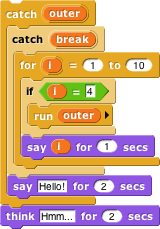
As shown, this will say 1, then 2, then 3, then exit both nested catches and think “Hmm.” If in the run block the variable break is used instead of outer, then the script will say 1, 2, 3, and “Hello!” before thinking “Hmm.”
There are corresponding catch and throw blocks for reporters. The catch block is a reporter that takes an expression as input instead of a C-shaped slot. But the throw block is a command; it doesn’t report a value to its own continuation, but instead reports a value (which it takes as an additional input, in addition to the catch tag) to the corresponding catch block’s continuation:
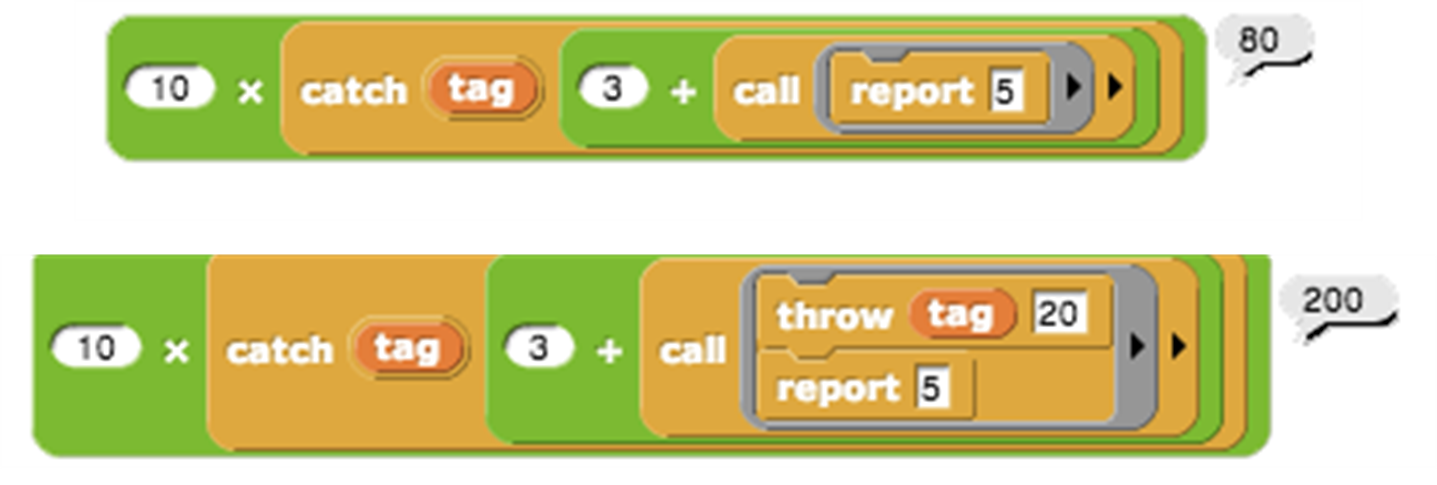
Without the throw, the inner call reports 5, the + block reports 8, so the catch block reports 8, and the × block reports 80. With the throw, the inner call doesn’t report at all, and neither does the + block. The throw block’s input of 20 becomes the value reported by the catch block, and the × block multiplies 10 and 20.
Creating a Thread System
Snap! can be running several scripts at once, within a single sprite and across many sprites. If you only have one computer, how can it do many things at once? The answer is that only one is actually running at any moment, but Snap! switches its attention from one script to another frequently. At the bottom of every looping block (repeat, repeat until, forever), there is an implicit “yield” command, which remembers where the current script is up to, and switches to some other script, each in turn. At the end of every script is an implicit “end thread ” command (a thread is the technical term for the process of running a script), which switches to another script without remembering the old one.
Since this all happens automatically, there is generally no need for the user to think about threads. But, just to show that this, too, is not magic, here is an implementation of a simple thread system. It uses a global variable named tasks that initially contains an empty list. Each use of the C-shaped thread block adds a continuation (the ringed script) to the list. The yield block uses run w/continuation to create a continuation for a partly done thread, adds it to the task list, and then runs the first waiting task. The end thread block (which is automatically added at the end of every thread’s script by the thread block) just runs the next waiting task.
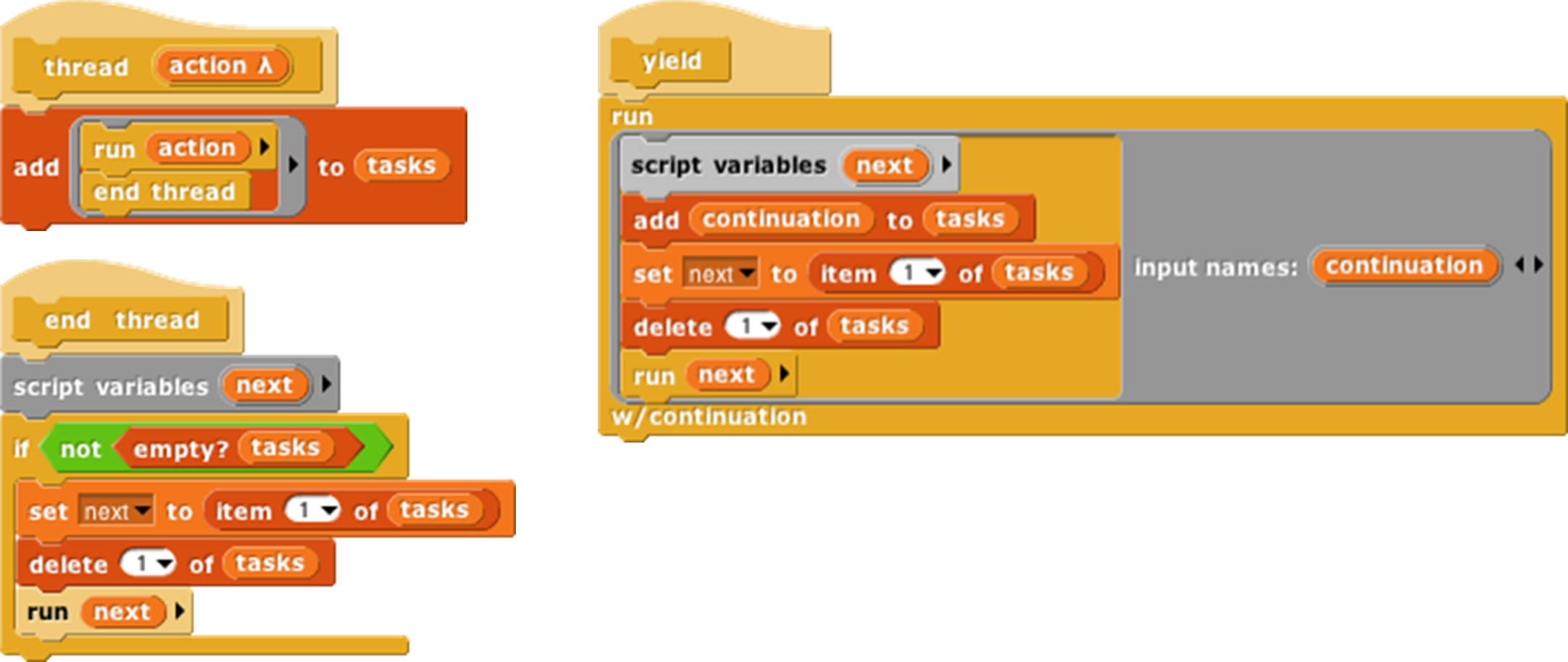
Here is a sample script using the thread system. One thread says numbers; the other says letters. The number thread yields after every prime number, while the letter thread yields after every vowel. So the sequence of speech balloons is 1,2,a,3,b,c,d,e,4,5,f,g,h,i,6,7,j,k,l,m,n,o,8,9,10,11, p,q,r,s,t,u,12,13,v,w,x,y,z,14,15,16,17,18,…30.

If we wanted this to behave exactly like Snap!’s own threads, we’d define new versions of repeat and so on that run yield after each repetition.
